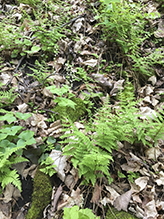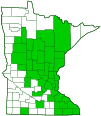twoleaf miterwort
(Mitella diphylla)
Conservation • Wetland • Description • Habitat • Ecology • Use • Distribution • Taxonomy
Description |
||
Twoleaf miterwort, also known as bishop’s cap, is a common, small, woodland wildflower. It occurs in the United States from New Hampshire to Minnesota south to Georgia and Arkansas, and in southern Quebec and Ontario Canada. It is common in the eastern two-thirds of Minnesota, where it reaches the western extent of its range, and mostly absent from the western third of the state. It is found in open upland forests and woodlands, on wooded hillsides and rocky bluffs, and in shady ravines. It grows under partial shade in rich soil Twoleaf miterwort is a 4″ to 16″ (10 to 40 cm) tall perennial forb that rises on basal leaves and one to five flowering stalks from a short, stout, underground stem (rhizome). Basal leaves are 9⁄16″ to 3⅜″ (1.4 to 8.5 cm) long, and 9⁄16″ to 3¾″ (1.4 to 9.6 cm) wide, about as long to slightly longer than wide. They are on ¾″ to 7″ (1.8 to 18.0 cm) long leaf stalks. The petiole is moderately to densely covered with long, backward-pointing, white or tan, gland-tipped hairs, and also sparsely to densely covered with minute stalked glands. The leaf blades are egg-shaped to nearly circular in outline and have usually 3, sometimes 5 shallow lobes. They are palmately veined with usually 5 primary veins, and are heart shaped at the base. The tip of the middle (terminal) lobe is narrowly angled. The upper surface is green and may be hairless or sparsely to moderately covered with long and short hairs. It is sometimes sparsely covered with minute glands near the base. The lower surface is pale green to grayish-green and is sparsely to moderately covered with hairs and glands, especially along the veins. The margins are finely to coarsely scalloped or toothed. The inflorescence is 1 to 5 erect, unbranched, spike-like flowering stalks (racemes) rising from the rhizome. Each raceme has 5 to 22 or more widely spaced flowers and a single pair of opposite leaves. This is the feature that gives the plant both its common name and species epithet. These leaves are short stalked to almost stalkless, longer than wide, ⅝″ to 3″ (1.6 to 8.0 cm) long, ¼″ to 2½″ (0.7 to 6.5 cm) wide, and otherwise similar to basal leaves. The stalk of the raceme is moderately to densely covered with minute stalked glands below the pair of leaves, and covered with long, downward-pointing, gland-tipped hairs above the leaves. Each flower is on a short stalk (pedicel). Each flower is about 3⁄16″ (5 mm) wide and looks like a snowflake. There are 5 outer floral leaves (sepals), 5 petals, 10 stamens, and 2 styles. At the base of the flower is an extension of the pedicel (hypanthium) formed from the fused bases of the sepals, petals, and stamens. The hypanthium is broadly and shallowly bell-shaped, 1⁄32″ to 1⁄16″ (1.0 to 1.6 mm) long and 1⁄16″to ⅛″ (2 to 4 mm) wide. The sepals (together the calyx) are greenish-white, triangular, 1⁄32″ (1.0 to 1.3 mm) long and 1⁄32″ (0.8 to 1.1 mm) wide. The petals are white, 1⁄16″to ⅛″ (2 to 4 mm) long, and finely lobed (fringed) with 9 to 15 spreading linear lobes. The stamens have white stalks (filaments) and pale yellow anthers. They are much shorter than the calyx. The styles are short and have crescent-shaped stigmas. The fruit is a broadly egg-shaped, 2-beaked, open capsule containing 4 to 40 shiny black seeds. The shape resembles a bishop’s cap (miter). This feature is the source of both the common name and the genus name. |
||
Height |
||
4″ to 16″ (10 to 40 cm) |
||
Flower Color |
||
White |
||
Similar Species |
||
Habitat |
||
Moderately moist to dry. Upland forests and woodlands, wooded hillsides, rocky bluffs, and shady ravines. Partial shade. Rich soil. |
||
Ecology |
||
Flowering |
||
May to June |
||
Pests and Diseases |
||
|
||
Use |
||
|
||
Distribution |
||||
|
Sources |
|||
| 12/24/2021 | ||||
Nativity |
||||
Native |
||||
Occurrence |
||||
Common |
||||
Taxonomy |
|||
| Kingdom | Plantae (Plants) | ||
| Division | Tracheophyta (Vascular Plants) | ||
| Subdivision | Spermatophytina (Seed Plants) | ||
| Class | Magnoliopsida (Dicots) | ||
Order |
Saxifragales (saxifrages, stonecrops, and allies) | ||
Family |
Saxifragaceae (saxifrage) | ||
Genus |
Mitella (miterworts) | ||
Subordinate Taxa |
|||
|
|||
Synonyms |
|||
Mitella oppositifolia |
|||
Common Names |
|||
bishop’s-cap coolwort miterwort two-leaf mitella twoleaf miterwort two-leaf miterwort |
|||
Glossary
Calyx
The group of outer floral leaves (sepals) below the petals, occasionally forming a tube. Plural: calyces.
Filament
On plants: The thread-like stalk of a stamen which supports the anther. On Lepidoptera: One of a pair of long, thin, fleshy extensions extending from the thorax, and sometimes also from the abdomen, of a caterpillar.
Hypanthium
A cup-like tubular structure of a flower formed from the fused bases of sepals, petals, and stamens, that surrounds the pistil. Its presence is diagnostic of many families, including Rosaceae, Ribes, and Fabaceae.
Linear
Long, straight, and narrow, with more or less parallel sides, like a blade of grass.
Palmate
Similar to a hand. Having more than three lobes or leaflets that radiate from a single point at the base of the leaf.
Petiole
On plants: The stalk of a leaf blade or a compound leaf that attaches it to the stem. On ants and wasps: The constricted first one or two segments of the rear part of the body.
Raceme
An unbranched, elongated inflorescence with stalked flowers. The flowers mature from the bottom up.
Rhizome
A horizontal, usually underground stem. It serves as a reproductive structure, producing roots below and shoots above at the nodes.
Sepal
An outer floral leaf, usually green but sometimes colored, at the base of a flower.
Visitor Photos |
|||||
Share your photo of this plant. |
|||||
| This button not working for you? Simply email us at info@MinnesotaSeasons.com. Attach one or more photos and, if you like, a caption. |
|||||
Nancy Falkum |
|||||
Two-leaf Miterwort Mitella diphylla with Hepaticas on the left and ferns |
|||||
 |
|||||
MinnesotaSeasons.com Photos |
|||||
|
|||||

Slideshows |
||

Visitor Videos |
|||
Share your video of this plant. |
|||
| This button not working for you? Simply email us at info@MinnesotaSeasons.com. Attach a video, a YouTube link, or a cloud storage link. |
|||
Other Videos |
|||
| On the Ground Bishop's Cap (Mitella diphylla) with Eric Comley, Garrard County 4-H YD Agent Epioblasma brevidens |
|||
About
Apr 12, 2021 It may be hard to see in the video, so I try to get some close-up still shots for the detail. Bishop's Cap (Mitella diphylla) is a cool to plant to observe, while "On the Ground." I hope you learn something and will keep your eyes out for this thin little plant. Enjoy. |
|||
| Two Leaf Miterwort Friends of the Cedarburg Bog |
|||
About
Jun 19, 2020 Two-Leaf Miterwort is a dainty spring flower that you need to get up close to really appreciate the flower's beauty. But the flower isn't the only amazing feature of this plant, check out how it uses rain to disperse it's seeds! |
|||
| The Miterwort! Pryce Durnye |
|||
About
Apr 10, 2021 In which, I stumble upon the Miterwort! They are miniscule and delicate but can grow up to two feet high. The flowers remind you of snowflakes. Only ants and other small pollinators |
|||

Visitor Sightings |
|||||
Report a sighting of this plant. |
|||||
| This button not working for you? Simply email us at info@MinnesotaSeasons.com. Be sure to include a location. |
|||||
| Nancy Falkum 5/14/2018 |
Location: Bald Eagle Bluff SNA Two-leaf Miterwort Mitella diphylla with Hepaticas on the left and ferns |
||||
MinnesotaSeasons.com Sightings |
|||||

Created: 12/24/2021
Last Updated:

